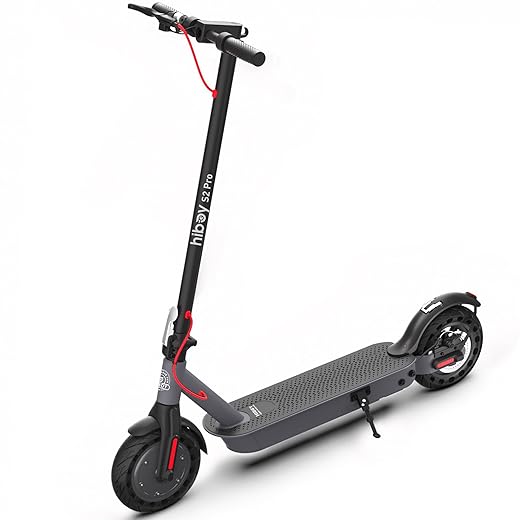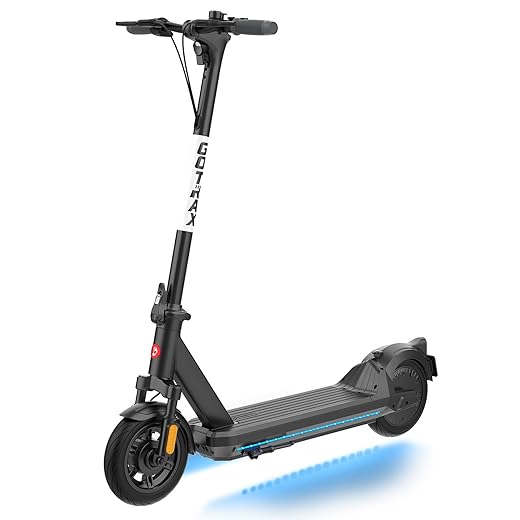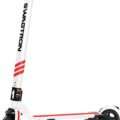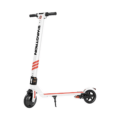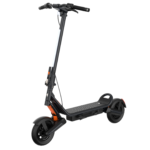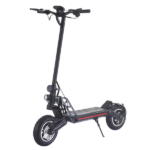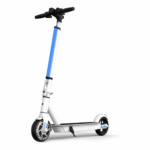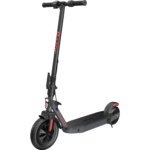- Home
- Scooters
- Compare Scooters
- GoTrax G4 vs Hiboy S2 Pro (Budget Commuter Showdown)
GoTrax G4 vs Hiboy S2 Pro (Budget Commuter Showdown)
Table of contents
- Key Takeaways
- Quick Specs: Side-by-Side
- What Matters Most for Commuters
- Ride Quality & Handling
- Performance: Speed, Acceleration, Hills
- Battery, Charging & Longevity
- Comfort, Portability & Build
- Features & App Experience
- Reliability, Warranty & Support
- Costs & Value Over Time (TCO)
- Use-Case Matchups
- Head-to-Head Verdict
- FAQs
- Glossary (Short)
- Headline Recap
- Price
Choosing a budget commuter scooter can feel like splitting hairs. However, the GoTrax G4 and Hiboy S2 Pro sit in the sweet spot for price-conscious riders who still want reliable speed, decent range, and everyday durability. Consequently, this in-depth comparison distills official specs, real-world considerations, and commuter-centric advice so you can pick the scooter that actually fits your routine.
Key Takeaways
- Both are true budget commuters. Expect roughly 19–20 mph (30–32 km/h) top speed and a claimed range up to ~25 miles (40 km) under ideal conditions. Moreover, both deliver city pace without breaking the bank.
- Ride feel differs. The G4 uses 10″ pneumatic (air) tires for natural damping; meanwhile, the S2 Pro uses 10″ honeycomb (solid) tires plus dual rear shocks to offset their firmness.
- Security and app features diverge. The G4 includes a built-in cable lock and PIN-style digital code lock; by contrast, the S2 Pro offers the Hiboy S2 app with remote lock and configurable settings.
- Water readiness isn’t identical. The S2 Pro lists IPX4 (splash resistance). Conversely, the G4’s materials emphasize UL safety and general wet-weather guidance; therefore, treat it as light-rain only.
- Weight and portability are close. The G4 is about 37 lb (16.8 kg); the S2 Pro is 37.4 lb (17.0 kg). As a result, both fold quickly, yet neither is a featherweight for long stair carries.
- Warranty differs. The G4 lists 2 years on adult e-scooters, whereas the S2 Pro lists 1 year. Consequently, coverage length may influence daily riders.
- Quick picker:
- Pick the G4 if you value air tires for smoother road feel, built-in physical security, and a longer warranty.
- Pick the S2 Pro if you prefer maintenance-free tires, app locking and tuning, and factory rear suspension.
Quick Specs: Side-by-Side
| Spec | GoTrax G4 | Hiboy S2 Pro | Why it matters |
|---|---|---|---|
| Price (as of Oct 2025) | ~$549 (USD) | Often around ~$429 (USD) | Prices fluctuate; therefore, verify current promos. |
| Motor (rated / peak) | 500 W (avg) | 500 W rated / ~750 W peak | Power shapes acceleration and hill starts. |
| Battery (V, Ah, Wh) | 36 V, 10.4 Ah, ~374 Wh | 36 V, 11.6 Ah, ~418 Wh | Higher Wh generally yields longer real-world range. |
| Claimed range | Up to 25 mi / 40 km | Up to 25 mi / 40 km | Conditions strongly affect outcomes. |
| Top speed (claimed) | 20 mph / 32 km/h | 19 mph / 30 km/h | Both provide brisk urban pace. |
| 0–15 mph (0–25 km/h) | Not officially stated | Not officially stated | Brands rarely publish this; tests vary widely. |
| Hill ability | Not specifically stated | 15° (manufacturer-stated) | Slope claims can be optimistic; rider mass matters. |
| Tires | 10″ pneumatic | 10″ honeycomb (solid) | Air = comfort; solid = no flats. |
| Suspension | None on base trim | Dual rear shocks | Additional damping aids rough pavement. |
| Brakes | Hand brake + disc; motor assist typical | Dual braking (electronic + mechanical) | Controlled stops boost confidence. |
| Water resistance | Light-rain guidance | IPX4 (splash resistant) | Avoid heavy rain and deep puddles on both. |
| Weight | ~37 lb / 16.8 kg | ~37.4 lb / 17.0 kg | Portability is comparable. |
| Max load | Up to 264 lb / 120 kg (current page) | 220 lb / 100 kg | Heavier riders may prefer the G4. |
| Deck (L × W) | Not officially published | ~17.7″ × 6.1″ (450 × 155 mm) | Foot stance and comfort depend on size. |
| Folded size | Not officially published | ~45.3″ × 16.5″ × 19.3″ (1151 × 419 × 490 mm) | Storage under desks or in trunks. |
| Charger / charge time | 42 V 2 A; ~3–4.5 h (manual) | 100–240 V adapter; time varies | Faster charging increases flexibility. |
| Lighting | Headlight + tail light + display lock code | Headlight + tail/sidelights | Visibility is critical at night. |
| Display & modes | LCD with speed, battery, trip; cruise | LCD, modes, cruise | Readability reduces distraction. |
| App & security | No app; cable lock + PIN | Hiboy S2 app with lock | Security takes different paths. |
| Warranty | 2 years | 1 year | Coverage can reduce ownership risk. |
Notes:
- Wh (watt-hours) = V × Ah; therefore, 36 V × 10.4 Ah ≈ 374 Wh, and 36 V × 11.6 Ah ≈ 418 Wh.
- The G4’s max load has appeared as 220 lb in older manuals and 264 lb on the current product page; accordingly, we note the discrepancy.
What Matters Most for Commuters
Range Reality
Manufacturers quote best-case numbers: warm temperatures, smooth pavement, and a light rider at moderate speed. In practice, colder weather, higher speeds, hills, and heavier loads diminish range. Although both scooters claim up to 25 miles (40 km), the Hiboy’s larger battery (~418 Wh) slightly improves endurance—provided you ride gently. Conversely, because air tires reduce vibration losses, the G4 can feel more efficient on rough asphalt at the same pace. Ultimately, your habits—steady cruising versus frequent bursts—affect results the most.
Ride Comfort
Comfort reduces fatigue and, consequently, mistakes. The G4’s pneumatic tires flex over cracks and seams, which softens chatter. By comparison, the S2 Pro’s honeycomb solids never puncture, yet they ride firmer; therefore, Hiboy adds dual rear shocks to help. Even so, the handlebar can still transmit more buzz than an all-air setup. On truly broken pavement, air tires win; on clean city lanes, both ride acceptably.
Braking & Safety
Both scooters use mechanical braking with electronic assistance. Consequently, lever feel, rotor condition, pad quality, and tire grip all matter. Because the S2 Pro pairs regen/e-brake with a disc and runs solid tires, stopping feel remains predictable but slightly harsher over ripples. Meanwhile, the G4’s air tires add compliance as you squeeze down. Either way, practice controlled stops from ~15 mph (25 km/h) and maintain pads and cables regularly.
Portability
At roughly 37 lb (≈17 kg), each is liftable for a flight of stairs or a quick hop onto a train. Nevertheless, neither is a casual shoulder-carry for long distances. Fortunately, the folding mechanisms are quick and intuitive. If you’ll carry daily, consider a shoulder strap; additionally, pre-scout indoor storage.
Weather Readiness
Both scooters are best for dry-to-lightly damp commutes. Specifically, the S2 Pro lists IPX4, meaning splash resistance. Conversely, the G4’s materials emphasize UL safety and light-rain guidance; consequently, avoid heavy downpours and deep puddles on either model. After damp rides, dry the scooter and store indoors to preserve components.
Maintenance
G4: You’ll check tire pressure (often 45–50 psi) and occasionally patch or replace a tube. In return, you get better grip and comfort.
S2 Pro: You skip flats thanks to solid tires, yet you may tighten hardware and inspect rear shocks periodically. On both scooters, keep the brake system adjusted, the folding latch snug, and the deck bolts checked. Consequently, minor upkeep prevents bigger issues.
Ride Quality & Handling
The G4 feels planted and forgiving on patched streets because air tires deform over bumps. Moreover, steering is neutral, with enough stability at ~20 mph (32 km/h) to inspire confidence. The S2 Pro tracks straight and feels slightly “livelier” up front since solids don’t deform as much; however, the rear shocks reduce kickback, especially on expansion joints. Therefore, if your commute features older tarmac, the G4’s compliance becomes noticeable. If, instead, you hate flats more than you love plushness, the S2 Pro’s no-flat promise plus rear shocks remains compelling.
Performance: Speed, Acceleration, Hills
Both scooters cite similar top speeds (G4 20 mph / 32 km/h, S2 Pro 19 mph / 30 km/h). Although acceleration to 15 mph (25 km/h) is not officially published, 500 W hub motors on 36 V systems usually deliver brisk city starts—especially on flat ground. For hills, Hiboy lists 15° capability; nevertheless, angle marketing can be optimistic. Consequently, technique helps: start with momentum, keep knees flexed, and avoid stopping mid-slope. Heavier riders should prefer the G4’s higher published payload ceiling.
Battery, Charging & Longevity
- Chemistry & capacity: Both use 36 V lithium-ion packs. Notably, the S2 Pro’s 11.6 Ah (~418 Wh) offers ~12% more energy than the G4’s 10.4 Ah (~374 Wh).
- Charging: The G4 typically uses a 42 V / 2 A charger; its manual quotes ~3–4.5 hours. Meanwhile, the S2 Pro lists a wide 100–240 V adapter input; thus, charge times may vary by charger version.
- Care tips: Store between 10–25°C (50–77°F) when possible; furthermore, avoid full discharges and do not leave the scooter in hot sun or a cold trunk. For longevity, use 20–80% for daily cycling and ~50–60% for multi-week storage.
Comfort, Portability & Build
- Decks: The S2 Pro deck ~17.7″ × 6.1″ (450 × 155 mm) feels standard for shoulder-width stance. Although G4’s brand materials don’t publish exact deck size, both feel adequate for urban riding.
- Fold & carry: Each folds quickly with a front-latch mechanism. Crucially, secure the clasp fully; a loose latch is the most common source of stem play.
- Frames & finishes: Both use aluminum alloys. Consequently, expect normal commuter wear on bar ends, kickstand, and fenders over time; periodic tightening reduces rattles.
Features & App Experience
- GoTrax G4: Clear LCD, cruise control, and notably two security layers—a built-in cable/tiller lock and a three-digit display lock code. As a result, casual misuse becomes less likely.
- Hiboy S2 Pro: The Hiboy S2 app lets you lock/unlock, toggle lights, switch modes, and adjust limits. Additionally, cruise control and a three-light system (head/tail/sidelights) aid visibility.
Reliability, Warranty & Support
- G4: 2-year coverage is strong in this price tier. Accordingly, keep proof of purchase and document issues with photos or video.
- S2 Pro: 1-year coverage remains standard for the class. Nevertheless, Hiboy provides troubleshooting, manuals, and app updates.
- Wear parts: Expect brake pads, tires, and possibly rear shock bushings (S2 Pro) to be typical consumables. Sensible speeds, smooth braking, and indoor storage, therefore, extend service life.
Costs & Value Over Time (TCO)
Electric scooters are exceptionally cheap to “fuel.” Consequently, energy often represents the smallest ownership cost.
- Energy use assumption: commuter scooters typically consume 15–25 Wh/mi (9–16 Wh/km), depending on speed, terrain, and rider mass.
- Electricity price example: $0.15 per kWh (adjust to your local rate).
Energy cost per 100 miles (160 km):
- At 15 Wh/mi → 1.5 kWh × $0.15 ≈ $0.23
- At 20 Wh/mi → 2.0 kWh × $0.15 ≈ $0.30
- At 25 Wh/mi → 2.5 kWh × $0.15 ≈ $0.38
Even at the high end, the figure stays well under fifty cents per 100 miles. Consequently, the bigger TCO drivers are tires, brakes, and time. Solids (S2 Pro) reduce flat-related downtime; conversely, pneumatics (G4) save wrists and improve grip, potentially reducing crash-related costs. Balance according to your roads.
Use-Case Matchups
Short, Flat City Hops
Either scooter works. Nevertheless, the S2 Pro’s no-flat tires and app lock make it a fuss-free errand runner.
Hilly Suburbs
Power is similar; however, the G4’s higher published payload and air tires help on imperfect pavement where traction matters.
Heavier Rider (≈100–120 kg)
The G4 is the safer bet given its up-to-264 lb (120 kg) published limit on the current product page. Consequently, taller or heavier riders may feel less constrained.
Winter or Frequent Rain
Neither is built for storms. Even so, the S2 Pro’s IPX4 rating is explicit, while the G4 should be treated as light-rain only. Therefore, ride slower, increase following distance, and dry the scooter afterward.
Apartment Carry or Train Hops
This is largely a toss-up. Since both weigh ~37 lb, choose based on features (G4 security vs S2 app). If you climb many stairs daily, consider a lighter model overall.
Head-to-Head Verdict
Below is a simple decision matrix (weights in parentheses). We score 1–10 per scooter based on official specs and typical class performance. Importantly, justifications emphasize commuter impact.
| Criteria (Weight) | GoTrax G4 | Hiboy S2 Pro | Rationale (brief) |
|---|---|---|---|
| Range (20%) | 7.5 | 8.0 | S2 Pro’s ~418 Wh pack provides a modest energy edge. |
| Ride Comfort (20%) | 8.0 | 7.0 | G4’s air tires smooth chatter; S2 Pro’s solids ride firmer despite rear shocks. |
| Braking (15%) | 7.5 | 7.5 | Both rely on mechanical + electronic assist; maintenance and tire contact dominate results. |
| Portability (15%) | 7.5 | 7.5 | Weight and folds are nearly identical; convenience ties. |
| Performance (15%) | 7.5 | 7.5 | 500 W on 36 V for both; top speed is very close. |
| Features (10%) | 8.0 | 8.0 | G4: cable + PIN; S2 Pro: app lock and tuning—different but equally useful. |
| Warranty (5%) | 9.0 | 7.0 | G4’s 2-year coverage outlasts S2 Pro’s 1-year policy. |
| Weighted Total | 7.8 / 10 | 7.6 / 10 | Margins are slim; road quality and preferences decide it. |
Overall verdict: You can’t go wrong with either scooter for sub-$600 commuting. If your streets are cracked, patched, or brick, the G4’s air tires and longer warranty tip the scales. Alternatively, if you hate flats and value app control, the S2 Pro is an easy keeper—especially when discounted.
FAQs
1) What’s the real-world range I should expect?
It depends on rider mass, speed, temperature, wind, elevation, and tire pressure. As a rule, plan for 60–70% of the claimed range for day-to-day routing; consequently, you’ll rarely be surprised.
2) Are solid tires harsh?
They ride firmer than pneumatics. Nevertheless, Hiboy adds rear shocks to soften impacts. Many riders accept the trade to avoid flats.
3) Can I ride in the rain?
Treat both as light-rain only. Specifically, the S2 Pro lists IPX4 (splashes). Therefore, avoid heavy rain and puddles, then dry and store indoors.
4) Which brakes are better?
Both use mechanical systems with electronic assistance. Consequently, proper adjustment and tire grip matter more than spec sheets.
5) Do they have cruise control?
Yes—both support cruise at a set speed. Even so, stay attentive and be ready on the brake.
6) Can I lock the scooter without an external lock?
G4: built-in cable/tiller lock plus PIN lock on the display.
S2 Pro: app lock via the Hiboy S2 app. Nevertheless, still use a quality U-lock or chain where theft risk is high.
7) What’s the max rider weight?
G4: up to 264 lb (120 kg) on the current product page, though some older manuals say 220 lb.
S2 Pro: 220 lb (100 kg). Consequently, heavier riders may lean G4.
8) Are replacement parts easy to find?
Yes—tires, tubes (G4), pads, levers are common. For S2 Pro, the honeycomb tires are model-specific yet widely stocked.
9) How long do they take to charge?
The G4 lists ~3–4.5 hours with a 42 V / 2 A charger. The S2 Pro varies by charger; consequently, plan for an evening charge.
10) Do I need to check bolts and the folding latch?
Yes. Periodic inspection and tightening prevent play and rattles. Therefore, focus on stem latch, brake caliper, rotor bolts, and fender mounts.
Glossary (Short)
- Wh (Watt-hours): Battery energy capacity; higher Wh usually means longer range.
- Regen/e-brake: Motor uses electromagnetic drag to slow you and recover a little energy.
- IP rating: Ingress Protection; IPX4 means splash resistant, not submersible.
- Honeycomb tires: Solid tires with internal voids that flex; immune to punctures but firmer.
- UL 2272: Safety standard covering electrical/charging systems for rideables in North America.
- Cruise control: Maintains a set speed until you brake or cancel; consequently, keep hands poised.
Headline Recap
If you crave comfort and security hardware, the GoTrax G4 is your commuter companion. Conversely, if you crave no-flat tires and app control, the Hiboy S2 Pro is your set-and-forget ride—especially when you catch it on sale.
Price
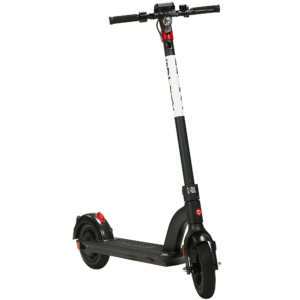  | |
| Price | |
| Our Rating | |
| Brand | GotraxHiboy |
| Category | Electric ScootersElectric Scooters |
General
| Model The Model specifies the exact version or name of the scooter. It helps identify its unique design, features, and specifications within the manufacturer’s product line. Knowing the model makes it easier to compare options, find compatible accessories, or look up support information. | G4S2 Pro |
| Brand The Brand identifies the manufacturer or company that designs and produces the scooter. A trusted brand is a sign of quality, reliability, and good customer support. Well-known brands often have higher standards for safety, performance, and after-sales service, giving you more confidence in your purchase. | GotraxHiboy |
| Release Date The Release Date indicates when the scooter model was officially launched on the market. This helps you know how current the design, technology, and features are. A newer release date often means updated components, improved performance, and the latest safety or smart features. | 01 May 202101 January 2024 |
| Recommended Age Recommended Age indicates the minimum age range that the scooter is designed for, based on safety, size, and ease of use. Following the recommended age helps ensure that riders can handle the scooter’s speed, weight, and controls comfortably and safely. Always check local laws and use protective gear, especially for younger riders. | 16+ years16+ years |
Performance & Power
| Motor Power (Wattage) What it means: The motor power, measured in watts (W), shows how strong the scooter’s electric motor is. Why it matters: Higher wattage usually means better acceleration, more torque, and improved performance on hills or rough terrain. For example, a 250W motor is good for flat city roads and light riders, while a 500W or 1000W motor provides more power for faster speeds or climbing steep inclines. | 350 W rated, up to 500 W peak350 W rated, up to 500 W peak |
| Top Speed The Top Speed indicates the maximum speed that the scooter can reach under optimal conditions. It’s usually measured on level ground with a fully charged battery and an average rider weight. A higher top speed allows you to travel longer distances faster, but always ensure you ride within legal speed limits and your personal comfort zone for safety. | 32 km/h (20 mph)30–31 km/h (19 mph) |
| Battery Capacity Battery Capacity refers to the total amount of energy the scooter’s battery can store, usually measured in ampere-hours (Ah) or watt-hours (Wh). A higher battery capacity means you can ride longer distances on a single charge, reducing the need for frequent recharging. Keep in mind that actual range can vary depending on rider weight, terrain, speed, and weather conditions. | 374 Wh (36V 10.4Ah lithium-ion)416 Wh (36 V, 11.6 Ah) |
| Estimated Range per Charge The Estimated Range per Charge indicates the average distance the scooter can travel on a single full battery charge. This range is calculated under optimal conditions, such as flat terrain, moderate speed, and average rider weight. Real-world range may vary depending on riding style, terrain, weather, and load. A longer range means fewer recharges and greater freedom for longer trips. | Up to 40 km (25 miles); real-world range closer to 19–23 km (12–15 miles)Up to 40 km (25 mi) claimed; ~40–42 km real-world under moderate use |
| Hill Climb Ability Hill Climb Ability describes the maximum incline or slope that the scooter can handle while maintaining stable performance. It’s typically expressed as a percentage or in degrees. A higher hill climb rating means the scooter can tackle steeper hills without losing too much speed or power. Actual climbing performance may vary based on rider weight, battery charge, and terrain conditions. | Up to 15° inclinesUp to 15° (~20% incline) |
| Drive System The Drive System refers to how power from the motor is delivered to the wheels. Electric scooters typically use either a hub motor (directly integrated into the wheel) or a chain/belt drive system. A high-quality drive system ensures smooth acceleration, efficient power transfer, and low maintenance. The choice of drive system affects performance, noise level, and overall ride experience. | Rear-wheel hub motorRear-wheel hub motor |
Charging & Electrical
| Charging Time Charging Time indicates how long it takes to fully recharge the scooter’s battery from empty to 100% using the standard charger provided. Faster charging means less downtime and more time on the road. Actual charging time may vary slightly depending on battery capacity, charger output, and environmental conditions. | ~4–5 hours4–6 hours |
| Battery Type Battery Type refers to the specific technology used in the scooter’s battery, which affects performance, lifespan, weight, and charging time. Most modern electric scooters use high-quality lithium-ion (Li-ion) batteries because they offer a good balance of energy density, durability, and low maintenance. A reliable battery type ensures consistent power delivery and longer riding ranges. | Lithium-ion with Smart BMS protectionLithium-ion with Smart BMS protection |
| Removable Battery A Removable Battery means the battery pack can be easily detached from the scooter for convenient charging and replacement. This feature allows you to charge the battery separately, swap it with a spare for extended range, or securely store it indoors in extreme weather. Removable batteries add flexibility and make it easier to keep your scooter powered up wherever you are. | NoNo |
| Regenerative Braking Regenerative Braking is an energy-saving feature that converts some of the energy normally lost during braking back into battery power. When you slow down or brake, the motor works in reverse to generate electricity, which helps extend the scooter’s range and improves overall efficiency. This system also reduces wear on traditional brake components, leading to lower maintenance over time. | YesYes |
| Lighting Lighting refers to the built-in front and rear lights that enhance visibility and safety when riding in low-light conditions or at night. Good lighting helps you see the road ahead and ensures that other road users can see you. Many scooters include LED headlights, taillights, and sometimes brake lights or side reflectors for added safety and compliance with local traffic regulations. | Bright LED headlight, rear tail/brake light, side reflectorsFront LED headlight, side accent lights, rear LED brake light; app-controlled |
Build & Dimensions
| Scooter Weight Scooter Weight refers to the total weight of the scooter when fully assembled, including the battery. This affects how easy it is to carry, lift, and store the scooter when not in use. A lighter scooter is more portable and convenient for commuting, especially if you need to carry it upstairs or onto public transport. Keep in mind that a sturdy frame and quality components may add to the weight but also contribute to better durability and ride stability. | ~16.7 kg (37 lb)~16.5 kg (36 lb) |
| Maximum Rider Weight Maximum Rider Weight indicates the highest rider weight that the scooter is designed to safely support while maintaining optimal performance and stability. Staying within this limit helps ensure reliable acceleration, braking, and climbing ability, and it protects the frame, suspension, and motor from excessive strain. Exceeding the recommended limit may reduce performance and increase wear on components. | 220 lb (100 kg)100 kg (220 lb) |
| Deck Size Deck Size refers to the dimensions of the scooter’s standing platform. A wider and longer deck provides more foot space, allowing you to stand comfortably and adjust your stance while riding. A well-sized deck improves balance and stability, especially on longer rides or at higher speeds. Compact decks, on the other hand, help keep the scooter lightweight and portable. | Wide slip-resistant standing platform (~160 mm)Standard non-slip platform |
| Handlebar Height Handlebar Height refers to the distance from the deck to the handlebars, which affects your riding posture and comfort. An appropriate handlebar height helps you maintain good balance, reduces strain on your back and arms, and makes steering more comfortable. Some scooters have adjustable handlebars to fit riders of different heights, while others have a fixed height for a streamlined design. | Fixed T-bar designFixed |
| Folding Mechanism The Folding Mechanism describes how easily and securely the scooter can be folded for carrying and storage. A well-designed folding system lets you quickly collapse the scooter into a compact size, making it convenient to transport on public transit, store under a desk, or fit into a car trunk. Look for sturdy latches and safety locks to ensure the scooter stays firmly in place when folded or unfolded. | YesYes |
| Dimensions Folded Dimensions indicate the size of the scooter when it’s fully folded. This measurement shows how much space the scooter will take up when stored or carried, making it easier to check if it will fit in your car trunk, under a desk, or in a closet. Compact folded dimensions are ideal for commuters who need to bring their scooter on public transport or store it in tight spaces. | Compact for storage in cars, offices, and apartmentsApprox. 116 × 42 × 49 cm (45.6 × 16.5 × 19.3 in) |
| Material Material refers to the primary construction materials used for the scooter’s frame and key components. High-quality materials like aircraft-grade aluminum, reinforced steel, or durable composites provide strength, stability, and a lighter overall weight. A sturdy material ensures the scooter can handle daily wear and tear while maintaining safety and performance. | Aluminum alloy frameAluminum alloy frame |
Safety & Control
| Brake Type(s) Brake Type(s) describe the braking systems the scooter uses to help you slow down or stop safely. Common brake types include mechanical brakes (like drum or disc brakes), electronic brakes, and foot brakes. Many scooters combine multiple braking systems for added safety and shorter stopping distances. The type and quality of brakes affect your control, especially when riding at higher speeds or on slopes. | Dual braking: rear disc + front electromagnetic brakeFront regenerative brake and rear mechanical disc brake |
| Suspension Suspension refers to the system that absorbs shocks and vibrations while riding, providing a smoother and more comfortable ride over uneven or rough surfaces. Scooters may have front suspension, rear suspension, or dual suspension for better shock absorption and stability. Good suspension helps reduce rider fatigue and improves control, especially when riding on bumpy roads or off-road paths. | NoneDual rear spring suspension |
| Tire Type Tire Type refers to the kind of tires the scooter uses, which directly affects ride comfort, traction, and maintenance. Common types include solid (airless) tires, pneumatic (air-filled) tires, or hybrid options. Pneumatic tires offer better shock absorption and a smoother ride on rough surfaces, while solid tires are puncture-proof and require less upkeep. The right tire type helps ensure safe handling and a comfortable ride in different conditions. | 10″ pneumatic air-filled tires10″ honeycomb solid tires (puncture-proof) |
| Tire Size Tire Size indicates the diameter and width of the scooter’s tires, which affect ride comfort, stability, and how well the scooter handles different terrains. Larger tires generally offer better shock absorption and a smoother ride over bumps and rough surfaces, while smaller tires keep the scooter lighter and more portable. Choosing the right tire size helps ensure a balance between agility and comfort. | 10″ (front & rear)10″ (front & rear) |
| Kickstand The Kickstand is a built-in stand that allows you to park your scooter upright when it’s not in use. A sturdy kickstand keeps the scooter stable and prevents it from tipping over, protecting it from scratches and damage. It also makes storing and accessing your scooter more convenient, whether you’re at home, work, or on the go. | YesYes |
| Water Resistance Rating Water Resistance Rating indicates how well the scooter is protected against water and moisture, usually shown as an IP (Ingress Protection) rating. This rating helps you understand whether the scooter can handle light rain, splashes, or wet roads without damage. While most scooters are not fully waterproof, a good water resistance rating adds peace of mind when riding in changing weather conditions. Always avoid deep puddles or submerging the scooter to protect its electrical components. | IP54 (dust/splash resistant)IP54 |
Features & Extras
| Display/Console The Display (or Console) shows important real-time information about your ride, helping you monitor your scooter’s status at a glance. Typical displays show speed, battery level, distance traveled, and riding mode. Some models also include additional features like Bluetooth connectivity, app integration, or backlighting for better visibility at night. A clear and easy-to-read display enhances safety and convenience on every trip. | Digital LED display for speed, battery, mode, and mileageLED dashboard showing speed, mode, and battery status |
| Ride Modes Ride Modes refer to the different speed and power settings you can choose to match your riding style or road conditions. Common modes include eco for maximum range and energy efficiency, standard for everyday balance, and sport or turbo for higher speed and stronger acceleration. Switching between ride modes allows you to customize performance, conserve battery, and ride safely in various environments. | Multiple speed modes including eco and max performanceTwo selectable speed modes; cruise control via app |
| Smart App Connectivity Smart App Connectivity lets you pair your scooter with a dedicated mobile app via Bluetooth. Using the app, you can monitor real-time ride stats like speed, battery level, and range, adjust settings such as ride modes or cruise control, lock the scooter for added security, and sometimes receive firmware updates. This feature adds convenience and allows you to personalize your riding experience right from your smartphone. | YesYes |
| Anti-Theft System The Anti-Theft System helps protect your scooter from unauthorized use or theft. This feature can include built-in alarms, electronic motor locks, GPS tracking, or remote locking through a mobile app. A good anti-theft system provides peace of mind when parking your scooter in public spaces, adding an extra layer of security to safeguard your investment. | Built-in electronic code lock + manual cable lock includedApp-based motor lock |
| Cruise Control Cruise Control allows you to maintain a steady speed without continuously holding the throttle. This feature makes longer rides more comfortable by reducing hand fatigue and providing a smoother, more relaxed riding experience — especially on flat, open roads or bike lanes. For safety, cruise control can usually be easily activated or deactivated while riding. | YesYes |
| Accessories Included Accessories Included lists the additional items that come with the scooter to enhance your riding experience and convenience. Common accessories may include a charger, kickstand, bell, lights, phone holder, or carrying strap. These extras add value by making your scooter safer, easier to use, and ready to ride straight out of the box. | Charger, manual, cable lock, Allen keyCharger, tools, user manual |
Warranty & Compliance
| Warranty Period The Warranty Period indicates how long the manufacturer guarantees the scooter against defects in materials and workmanship under normal use. A good warranty provides peace of mind, showing the brand’s confidence in its product quality. Always check what parts are covered, such as the frame, battery, and motor, and follow the maintenance guidelines to keep your warranty valid. | 12 months standard manufacturer warranty12 months (varies by region) |
| Certifications Certifications confirm that the scooter meets specific safety, quality, and environmental standards set by recognized organizations or regulatory bodies. Common certifications may include CE, RoHS, UL, or other local compliance marks, depending on your region. These certifications ensure that the scooter is manufactured to high standards and is safe and legal to use in your country. | UL, CE, RoHS, IP54 certified; compliant with most scooter road safety standardsIPX5/IPX6, CE (presumed standard Xiaomi certifications) |
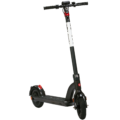  |


